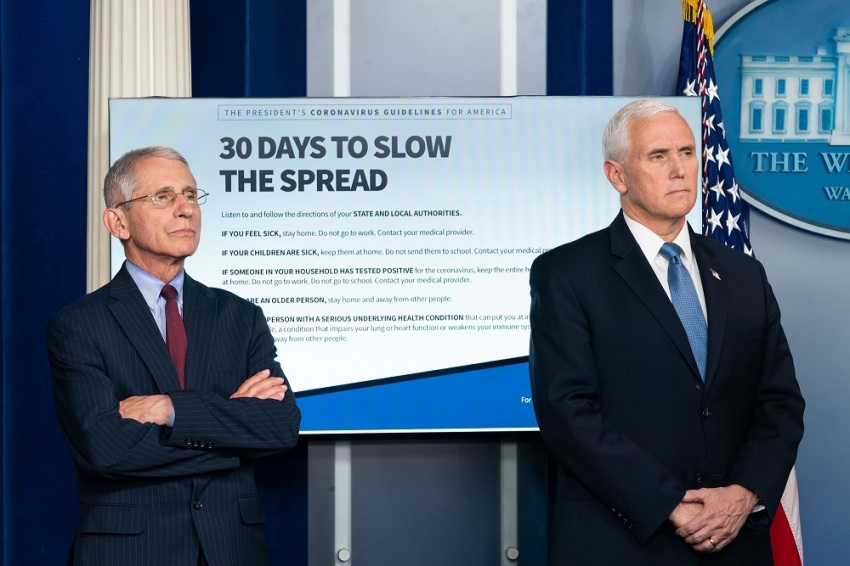Research from MIT prof. suggests coronavirus could travel 27 feet; Fauci calls it ‘misleading’

Dr. Anthony S. Fauci, director of the National Institute of Allergy and Infectious Diseases and member of the White House Coronavirus Task Force led by Vice President Mike Pence, called recent research by an MIT professor suggesting the new coronavirus could travel up to 27 feet “misleading.”
“I’m sorry, but I was disturbed by that report because that’s misleading,” Fauci said Tuesday, according to the New York Post.
In the research paper, titled "Turbulent Gas Clouds and Respiratory Pathogen Emissions," which was published in the Journal of the American Medical Association on March 26, MIT associate professor Lydia Bourouiba suggested that social distancing recommendations of six feet might not be enough to prevent people from spreading the deadly new coronavirus because they were developed using an outdated understanding of diseases transmission.
“In 1897, Carl Flügge showed that pathogens were present in expiratory droplets large enough to settle around an infected individual. ‘Droplet transmission’ by contact with the ejected and infected fluid phase of droplets was thought to be the primary route for respiratory transmission of diseases. This view prevailed until William F. Wells focused on tuberculosis transmission in the 1930s and dichotomized respiratory droplet emissions into ‘large’ and ‘small’ droplets,” Bourouiba wrote.
Infection control strategies were developed based on whether a respiratory infectious disease is primarily transmitted via the large or the small droplet route, she continued.
“The dichotomy of large vs small droplets remains at the core of the classification systems of routes of respiratory disease transmission adopted by the World Health Organization and other agencies, such as the Centers for Disease Control and Prevention. These classification systems employ various arbitrary droplet diameter cutoffs, from 5 to 10 μm, to categorize host-to-host transmission as droplets or aerosol routes. Such dichotomies continue to underlie current risk management, major recommendations, and allocation of resources for response management associated with infection control, including for COVID-19,” she said.
As the world struggles to contain the new coronavirus, Bourouiba suggested that this could be because of new research that suggests that exhalations, sneezes and coughs consist of not just droplets but “are primarily made of a multiphase turbulent gas (a puff) cloud that entrains ambient air and traps and carries within it clusters of droplets with a continuum of droplet sizes.”
She explained that in a turbulent gas cloud, droplets can live for much longer than when they are isolated.
“Under these conditions, the lifetime of a droplet could be considerably extended by a factor of up to 1000, from a fraction of a second to minutes. Owing to the forward momentum of the cloud, pathogen bearing droplets are propelled much farther than if they were emitted in isolation without a turbulent puff cloud trapping and carrying them forward,” she said.
How far these turbulent gas cloud droplets travel, Bourouiba explained, is impacted by a person’s physiology as well as environmental conditions such as humidity.
“Given various combinations of an individual patient’s physiology and environmental conditions, such as humidity and temperature, the gas cloud and its payload of pathogen bearing droplets of all sizes can travel 23 to 27 feet,” she said.
Fauci said at a White House press briefing, however, that it would take a “very, very robust, vigorous, achoo sneeze” for droplets to even come close to traveling such a distance.
Bourouiba noted in her paper: “A 2020 report from China demonstrated that severe acute respiratory syndrome coronavirus 2 (SARS-CoV-2) virus particles could be found in the ventilation systems in hospital rooms of patients with COVID-19. Finding virus particles in these systems is more consistent with the turbulent gas cloud hypothesis of disease transmission than the dichotomous model because it explains how viable virus particles can travel long distances from patients. Whether these data have clinical implications with respect to COVID-19 is unknown.”
As a result of this “unknown,” she suggested that it could generate “an underappreciated potential exposure range for a health care worker” and recommended that they wear “appropriate personal protection equipment,” which would also need to be improved beyond the current standard of PPEs like N95 masks.
“The protective efficacy of N95 masks depends on their ability to filter incoming air from aerosolized droplet nuclei. However, these masks are only designed for a certain range of environmental and local conditions and a limited duration of usage. Mask efficacy as source control depends on the ability of the mask to trap or alter the high-momentum gas cloud emission with its pathogenic payload,” she said. “Currently used surgical and N95 masks are not tested for these potential characteristics of respiratory emissions.”
She added: “There is a need to understand the biophysics of host-to-host respiratory disease transmission accounting for in-host physiology, pathogenesis, and epidemiological spread of disease. The rapid spread of COVID-19 highlights the need to better understand the dynamics of respiratory disease transmission by better characterizing transmission routes, the role of patient physiology in shaping them, and best approaches for source control to potentially improve protection of front-line workers and prevent disease from spreading to the most vulnerable members of the population.”



























